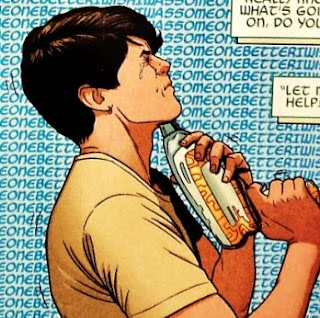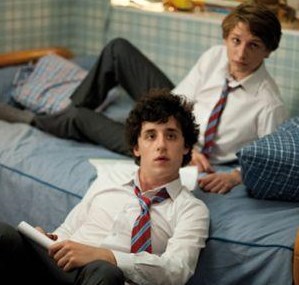And what a fight! Jamie McKelvie turns a double page spread into a game board, a picturesque sequence that shows Noh-Varr’s attack step by step in miniature, while spotlighting specific moments in larger frames on the contours of the page. This is a visual exercise that embraces comic books as a rich and complex medium, as an artistic expression that can be more powerful and dynamic than anything else, provided that the artists are willing to take risks and use their imagination.
After destroying a dozen of opponents in seconds, Noh-Varr thinks about his sexual relationship with Kate Bishop (AKA Hawkeye) and remembers the original (male) Hawkeye from the Avengers. “We didn’t make love. He was a man”, he admits to himself. And then, after saving Wiccan (Billy), Hulkling (Teddy), Kid Loki and Ms. America he knows exactly what to say: “Come with me if you want to be awesome”, which is an absolutely wonderful homage to one my favorite lines from “Terminator 2” (“Come with me if you want to live”).
 |
| A very dynamic game board / Un juego de mesa muy dinámico |
Of course, now it’s the turn for Marvel Boy’s dead parents to return to life, just like Loki’s father did on a previous issue. Attacked by all their dads and moms –dead or alive– the Young Avengers barely manage to escape. Meanwhile, Kid Loki continues to be the god of mischief, and starts poisoning Teddy’s mind. “You are a very lovely daydream”, tells the Norse god to the prince of the Skrull Empire, but what are the odds of a (gay) prince charming finding Billy, on the same city, on the same school? Does Billy’s altering reality powers had anything to do with their first encounter?
“Let’s go save the world from us”, says Loki. And indeed, so far the Young Avengers have been doing nothing but defending themselves from the magic threats accidentally created by Billy. But the time for the final confrontation between adults and teenagers is finally here.
 |
| Marvel Boy is awesome! / ¡Marvel Boy es genial! |
Jamie McKelvie never ceases to amaze me thanks to his daring page designs, his stunning rendering of heroes and ordinary people; his lines are a delightful melody, perhaps akin to the disc that plays during Marvel Boy's brilliant battle scene. Even the credits page is a terrific illustration that reminds us of classic noir films.
I absolutely loved this issue. Oh yeah, and the best part, my letter got published! I’m including it here so read it and enjoy it.
Dear Gillen & McKelvie:
I was young once. Granted, at 28, some might still consider me young but I have a gnawing suspicion that the Young Avengers would consider me too old to join their ranks. Still, when Allan Heinberg’s first issue of Young Avengers came out I was still indisputably young… and an enthusiastic fan of Hulkling and Wiccan. I had to wait literally years before I actually saw them kissing on the page, but I’m thrilled to see that whatever controversy this kiss could have caused in the past it’s no longer an issue, or at least not a terribly huge deal (my stars and garters! does that mean people are slightly more tolerant now?). I wasn’t completely sure about picking up this new YA series. Honestly, I was sure no one –and I do mean NO ONE– would be able to be at least half as good as Heinberg & Cheung. But Gillen & McKelvie, in just one issue, you proved to be every bit as good and great as the original creative team. Damn, I certainly did not expect that. Now I’m absolutely excited about this new iteration of the team: I welcome Marvel Boy and Kid Loki with open arms, and I’m glad to see that Billy and Teddy –the emotional core of the team– are back. This is, hands down, the best new Marvel series. Now I feel young again. And for that I am very thankful.
Arcadio Bolaños.
Lima, Perú.
Gillen's reply is just hilarious:
Arcadio, I'd rather say something sensible about your kind letter, but I'm stunned by your brilliant name. I'm going to tell everyone to call me Arcadio Bolaños for the rest of the day. No one will obey me, but that's neither here nor there. - KG
_________________________________________________________________
_________________________________________________________________
 |
| The attack of the Marvel parents / El ataque de los padres Marvel |
"No hicimos el amor. Él era un hombre". Marvel Boy (Noh-Varr) no es un muchachito ordinario. Tiene la inteligencia, la tecnología, el entrenamiento y el temple para conquistar la Tierra si quisiera hacerlo. Eso era evidente en la interpretación de Grant Morrison y sigue siendo cierto en la versión de Kieron Gillen. Él aterriza en la Tierra en el momento justo, y pone en la mira a la madre de Teddy y al resto de progenitores poseídos, y en cuestión de segundos les da una pateadura de culo a todos.
¡Y vaya pelea! Jamie McKelvie convierte una página doble en un juego de mesa, una secuencia pintoresca que muestra el ataque de Noh-Varr paso a paso en miniatura, mientras que resalta momentos específicos en viñetas más grandes en los contornos de la página. Este es un ejercicio visual que asume al cómic como un medio rico y complejo, como una expresión artística que puede ser más poderosa y dinámica que ninguna otra, siempre y cuando los artistas estén dispuestos a arriesgarse y a usar su imaginación.
 |
| teenagers versus adults! / ¡adolescentes versus adultos! |
Después de destruir docenas de oponentes en segundos, Noh-Varr piensa en su relación sexual con Kate Bishop (Hawkeye) y recuerda al Hawkeye original (masculino) de los Avengers. "No hicimos el amor. Él era un hombre", admite. Y luego, después de salvar a Wiccan (Billy), Hulkling (Teddy), Kid Loki y Ms. America, sabe exactamente qué decir: "Ven conmigo si quieres ser genial" que es un homenaje absolutamente maravilloso a una de mis frases favoritas de “Terminator 2” (“Ven conmigo si quieres vivir”).
Por supuesto, ahora toca que los padres muertos de Marvel Boy resuciten, tal como sucedió con el padre de Loki en el número anterior. Atacados por todos sus papás y mamás -vivos o muertos- los Jóvenes Vengadores apenas se las arreglan para escapar. Mientras tanto, Kid Loki continúa siendo el dios de las triquiñuelas, y empieza a emponzoñar la mente de Teddy. "Tú eres un ensueño muy adorable", le dice el dios nórdico al príncipe del Imperio Skrull, pero ¿cuáles son las probabilidades de que un príncipe azul (gay) encontrase a Billy, en la misma ciudad, en la misma escuela? ¿Los poderes de Billy, que alteran la realidad, tuvieron algo que ver con ese primer encuentro?
 |
| my published letter / mi carta publicada |
"Vayamos a salvar al mundo de nosotros", dice Loki. Y, de hecho, hasta ahora los Jóvenes Vengadores no han hecho otra cosa que defenderse de las amenazas mágicas accidentalmente creadas por Billy. Pero el momento de la confrontación final entre adultos y adolescentes finalmente está aquí.
Jamie McKelvie no deja de asombrarme gracias a su atrevido diseño de página, su precioso retrato de los héroes y las personas ordinarias; sus líneas son una melodía deliciosa, tal vez similar al disco que suena durante la brillante escena de batalla de Marvel Boy. Incluso la página de créditos es una estupenda ilustración que nos recuerda al cine negro clásico.
Realmente me encantó este número, y la mejor parte, ¡mi carta salió publicada! La incluyo aquí para que puedan leerla y disfrutarla.
Queridos Gillen & McKelvie:
Yo fui joven alguna vez. Cierto, a los 28, algunos todavía podrían considerar que soy joven, pero tengo la irritante sospecha que los Jóvenes Vengadores me considerarían demasiado viejo para unirme a sus filas. Aun así, cuando salió el primer número de Young Avengers de Allan Heinberg yo todavía era indisputablemente joven... y un entusiasta fan de Hulkling y Wiccan. Tuve que esperar literalmente años antes de poder verlos besándose en la página, pero estoy entusiasmado al ver que cualquier controversia que este beso podría haber causado en el pasado ya no es un problema, o por lo menos no un problema terriblemente grande (¡estrellas y jarreteras! ¿significará eso que la gente es ahora ligeramente más tolerante?). No estaba completamente seguro sobre esta nueva serie de Young Avengers. Honestamente, estaba seguro que nadie -y quiero decir NADIE- sería capaz de ser al menos la mitad de buenos que Heinberg & Cheung. Pero Gillen & McKelvie, en tan sólo un número, ustedes han demostrado ser tan buenos y tan grandiosos como el equipo creativo original. Maldición, ciertamente no me lo esperaba. Ahora estoy absolutamente emocionado con esta nueva encarnación del equipo: le doy la bienvenida a Marvel Boy y Kid Loki con los brazos abiertos, y me alegra ver que Billy y Teddy -el núcleo emocional del equipo- han regresado. Este es, de lejos, la mejor nueva serie de Marvel. Ahora me siento joven de nuevo. Y por eso esto muy agradecido.
Arcadio Bolaños.
Lima, Perú.
La respuesta de Gillen es hilarante:
Arcadio, preferiría decir algo sensato sobre tu generosa carta, pero estoy conmocionado por lo brillante que es tu nombre. Le voy a decir a todos que me llamen Arcadio Bolaños por lo que queda del día. Nadie me odedecerá, pero eso ni me va ni me viene. - KG













































































































